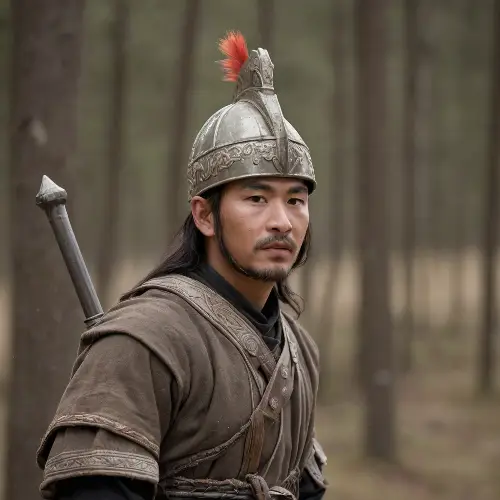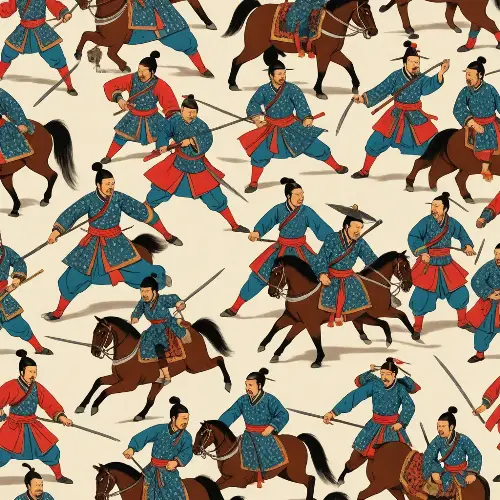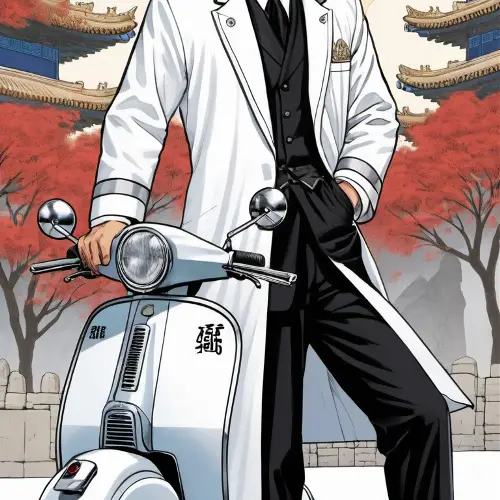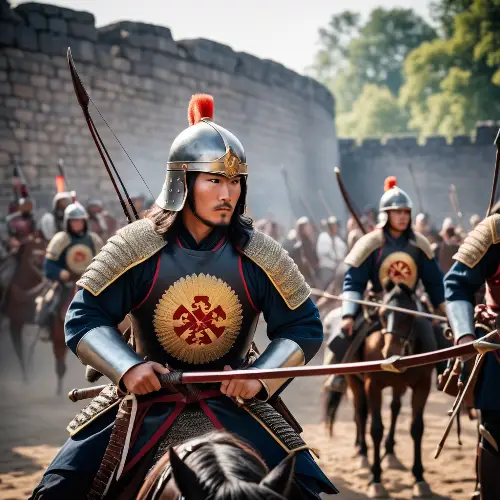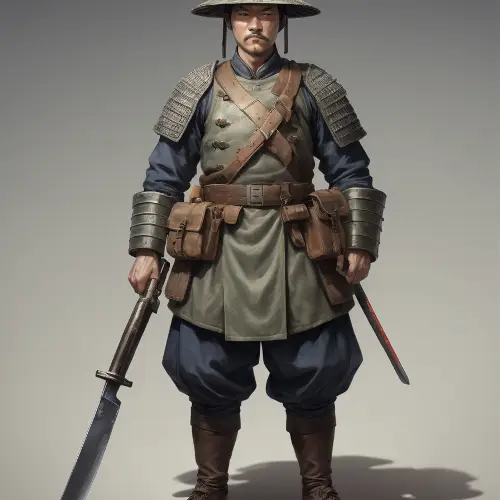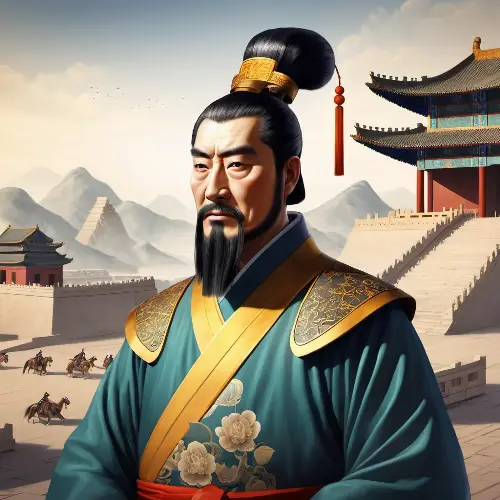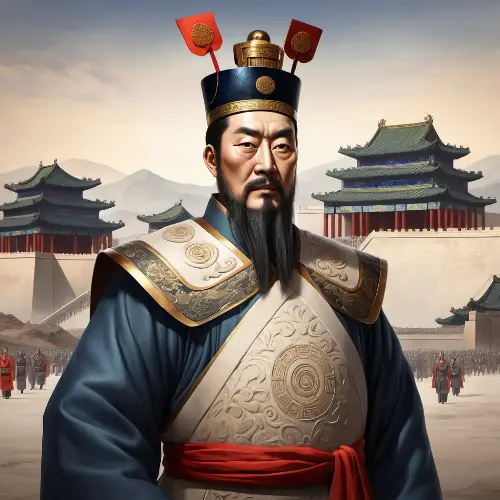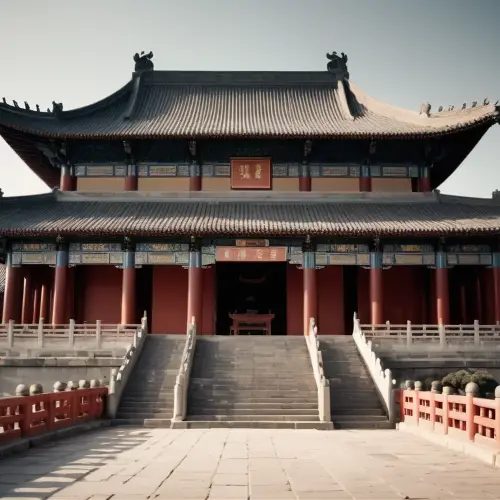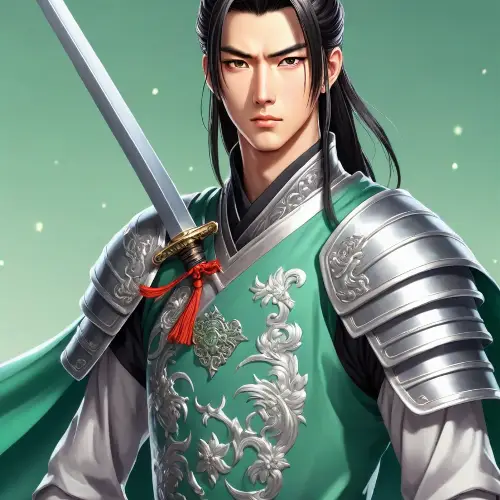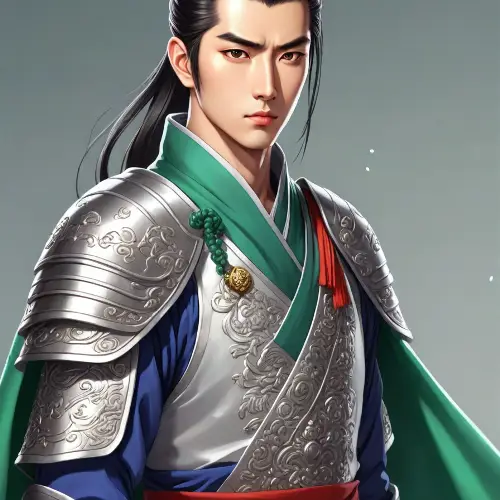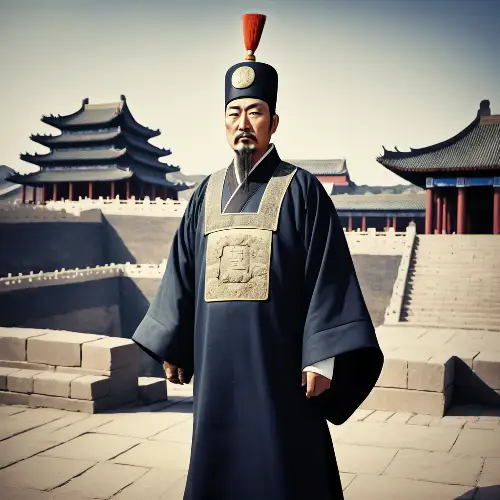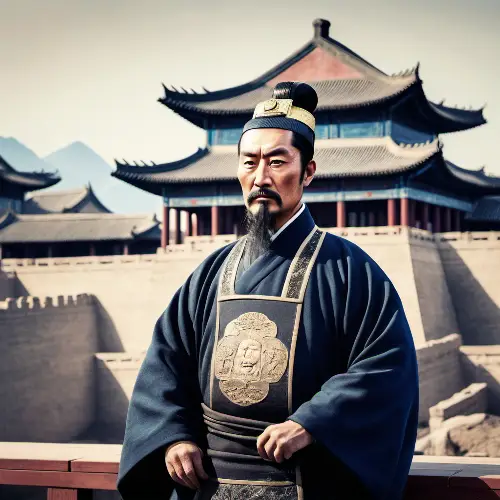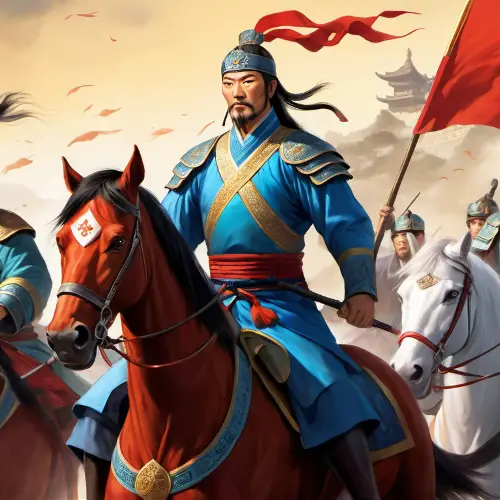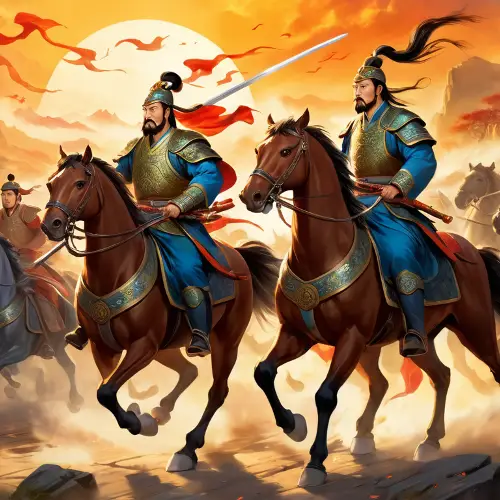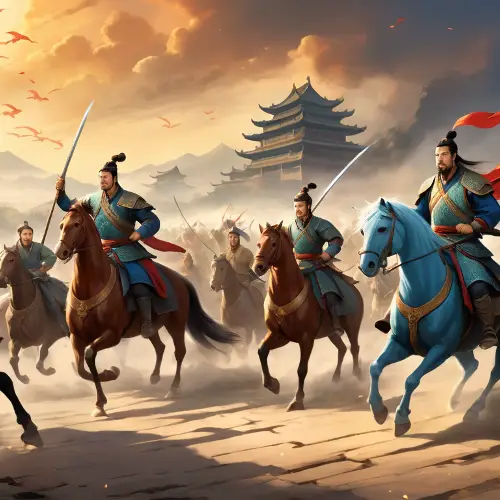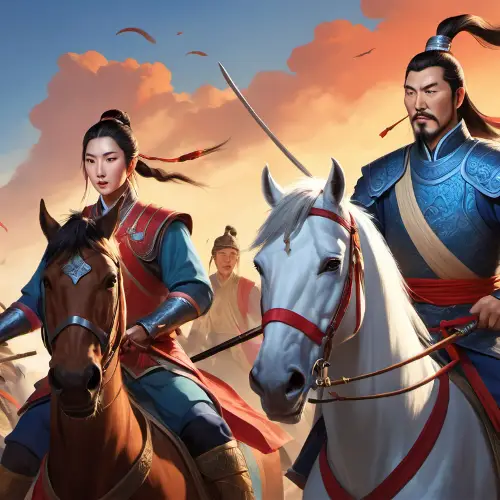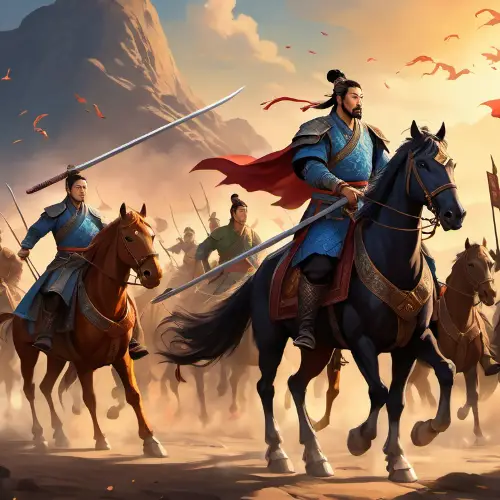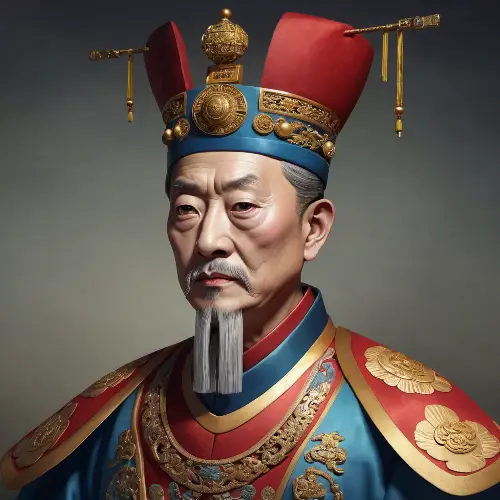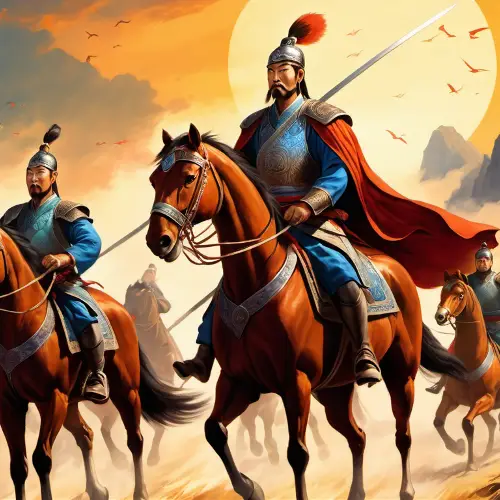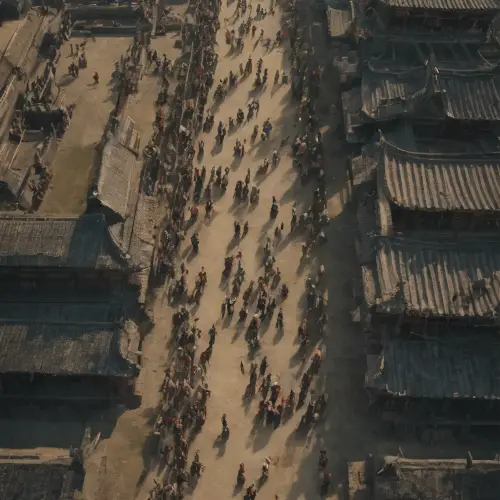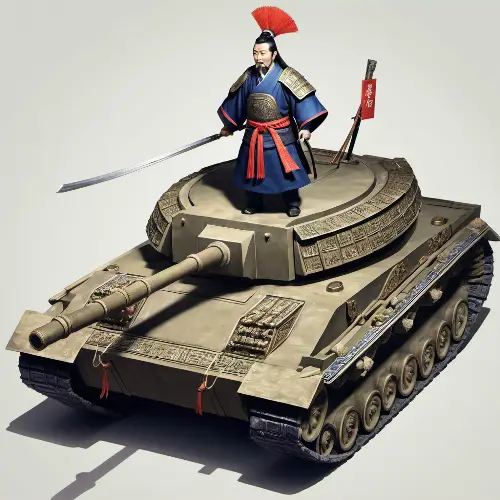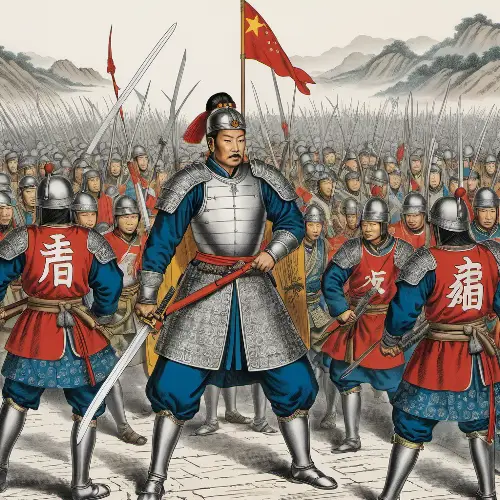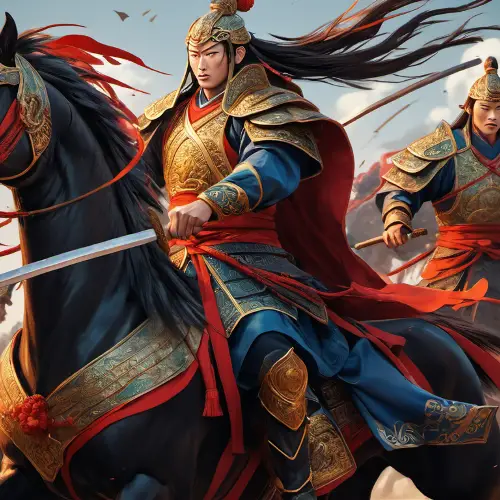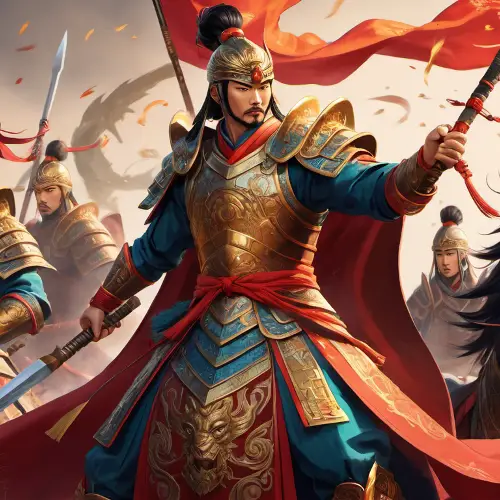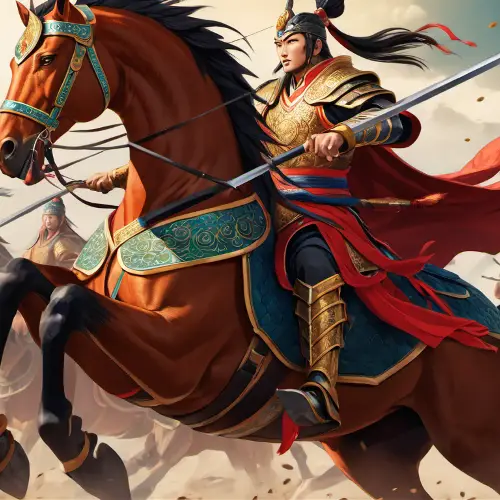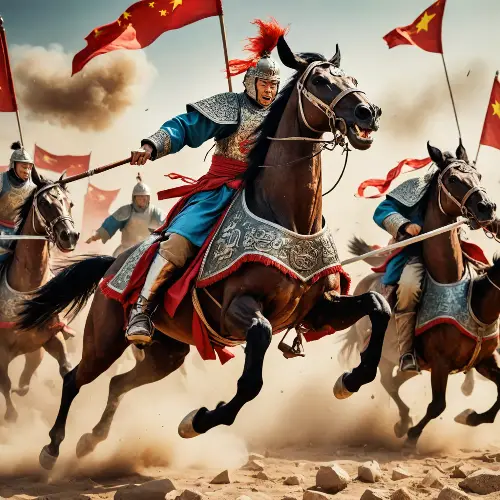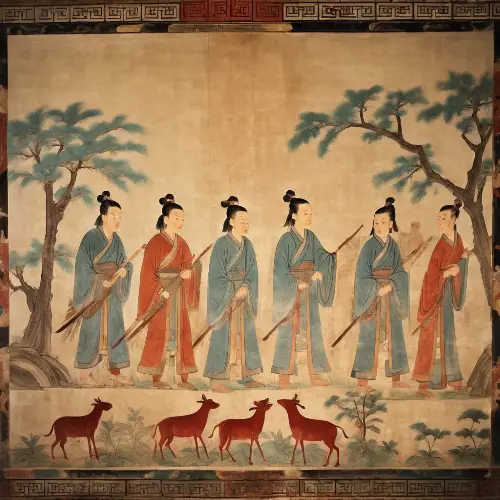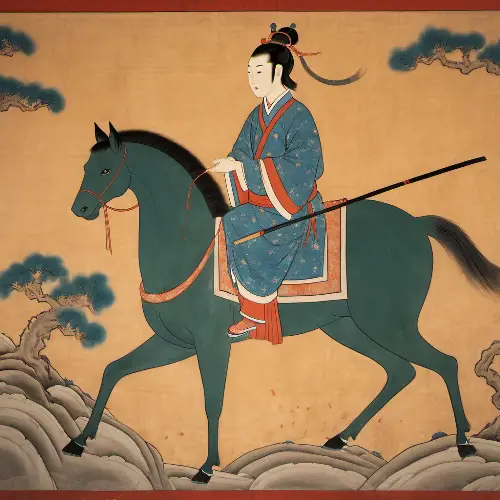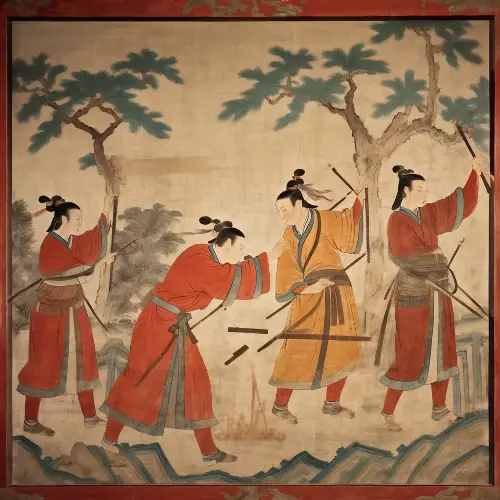In ancient China's Warring States period, King Ying Zheng of Qin sought to unify the six states. Displaying political acumen and military brilliance from a young age, he implemented strict laws and formed alliances with Qi, Wei, Yan, Chu, Zhao, and Han. Leading with unique military tactics, Ying Zheng achieved victories, notably at the Battle of Changping against Zhao. However, internal dissent arose due to harsh measures like book burnings. Despite this, Ying Zheng successfully established the Qin Dynasty, proclaiming himself Qin Shi Huang. His authoritarian rule, marked by forced labor and the quest for immortality, led to discontent, ultimately contributing to the downfall of the Qin Dynasty after his death. While Qin Shi Huang's legacy included the unification of China, it also brought about a legacy of oppression and discontent. The subsequent Han Dynasty sought a more balanced rule, embracing Confucianism and influencing the course of Chinese history. Ying Zheng's journey, marked by triumphs and tragedies, remains a complex narrative from a pivotal era.
More Like This
Male, with the background being the first Guanshan Customs in China, Emperor Qin Shi Huang of ancient China, Ying Zheng, wearing the imperial crown of the Qin Dynasty, a white shirt, a black tie, a military colored m51 windbreaker, black woolen pants, black Chelsea boots, and riding a silver white Vespa motorcycle
Siege scenes during the Warring States Period, bows and arrows, weapons, horses, soldiers, war, blood, resistance, city walls
During the Spring and Autumn Period and the Warring States Period, one side fought with a kitchen knife, and the other side was a tank machine gun Gatlin. The strength of the two sides was very different
Emperor Qin Shihuang,the first emperor in Chinese ancient history,palaces of Qin empire in back ground
Panoramic camera, a handsome young general of ancient China, dressed in simple silver Chinese armor, was handsome and handsome. He had a pair of dark eyes on his clearly outlined face, and his long black hair was tied into a high ponytail and a elegant cloak. He stood at the scene of the conflict in ancient China and moved forward bravely under his command.
Panoramic camera, a handsome young general of ancient China, dressed in simple silver Chinese armor, was handsome and handsome. He had a pair of dark eyes on his clearly outlined face, and his long black hair was tied into a high ponytail and a elegant cloak. He stood at the scene of the conflict in ancient China and moved forward bravely under his command.
Generate a highly detailed 8K image of an ancient Chinese temple, capturing the essence of 15th century China. The image should be nighttime with nocturnal tones, showing intricate architectural details, traditional elements and the cultural richness of the time. Emphasize the historical significance and beauty of the Chinese temple, transporting the viewer to the vibrant atmosphere of ancient China.
In an ancient battlefield during the Warring States period, a desolate scene unfolds. A sturdy citadel stands at the heart of the battlefield, its walls adorned with tattered flags swaying in the wind. Before the city, a snowy expanse blankets the battleground, rendering everything in a pristine white. Damaged chariot wheels, scattered weaponry, and fragmented armor faintly emerge amidst this white canvas, bearing witness to the brutal conflicts once waged here. The figures of soldiers amidst the snow appear solemn and burdened; some lie prone on the ground while others brandish their weapons. Their attire and armor, weathered and marked, speak of trials endured. Behind the citadel, the undulating snow-covered landscape stretches endlessly, pristine and untouched, as the falling snowflakes silently descend upon the battlefield, lending a sense of quietude and sorrow to this harsh tableau. The sky, filled with swirling white snowflakes, carries an icy chill, seemingly silently witnessing this poignant scene.
A handsome young general from ancient China, dressed in a simple silver Chinese style armor, was handsome and graceful. He had a well-defined face with a pair of black eyes, black long hair tied into a high ponytail, and a flowing cloak. He held a precious sword inlaid with jade and stones, and was the focus of attention
Emperor Qin Shihuang,the first emperor in Chinese ancient history,palaces of Qin empire in back ground,style:photographic
A picture depicting the trials of a Chinese prince, with political cunning, martial arts training, and scenes of dealing with internal and external conflicts intertwined.
A picture depicting the trials of a Chinese prince, with political cunning, martial arts training, and scenes of dealing with internal and external conflicts intertwined.
A picture depicting the trials of a Chinese prince, with political cunning, martial arts training, and scenes of dealing with internal and external conflicts intertwined.
Steeped in historical legend, this dramatic painting captures China's war against the Jin dynasty during the Southern Song period. The image is vividly detailed with Yue Fei and other valiant generals leading the charge. The color palette ranges from vibrant to muted, reflecting the intensity of the conflict. Facial expressions convey valor and determination as they are illuminated by the heat of battle. This illustration vividly summarizes the heroism of Yue Fei and the generals that ultimately led to the signing of the Liao Shui Peace Treaty.
Imagine Admiral Yi Sun-sin, leading the combined forces of the Joseon navy and the Ming Dynasty's army and navy, in a coordinated assault on the Japanese-occupied Suncheon Castle. Clad in his distinctive armor, Yi Sun-sin stands as a symbol of the unified strength between Korea and Ming, orchestrating a strategic and determined offensive against the common adversary. The scene unfolds amidst the intensity of the historical collaboration, capturing the spirit of solidarity in the face of adversity.
In this emotionally charged painting, viewers are transported to the center of China's war against the Jin Dynasty during the Southern Song Dynasty. Life-like characters, including Yue Fei and valiant generals, engage in epic battles that culminate in the signing of the Liao Shui Peace Treaty. The color palette dynamically transitions to reflect the intensity of the war and the peace that followed. Characters' expressions range from fiercely determined to relieved, all illuminated by the shifting tones of conflict and resolution. The animation vividly demonstrates the heroism that shaped the historical events.
In this emotionally charged painting, viewers are transported to the center of China's war against the Jin Dynasty during the Southern Song Dynasty. Life-like characters, including Yue Fei and valiant generals, engage in epic battles that culminate in the signing of the Liao Shui Peace Treaty. The color palette dynamically transitions to reflect the intensity of the war and the peace that followed. Characters' expressions range from fiercely determined to relieved, all illuminated by the shifting tones of conflict and resolution. The animation vividly demonstrates the heroism that shaped the historical events.
This painting depicts a heroic scene from the Chinese war against the Jin Dynasty during the Southern Song Dynasty in China. Richly textured and softly colored, the painting depicts scenes of Yue Fei and other valiant generals in battle. The color palette ranges from vibrant to muted, reflecting the ups and downs of the conflict. Facial expressions reflect a mixture of determination and sacrifice, and stand out against the dramatic lighting of the battlefield. The painting eloquently conveys the spirit of heroism that ultimately led to the signing of the Liaosu Peace Treaty.
Ancient Chinese civilization during warring period 350 BCE, realistic, top down view, civilization
Depicting a picture of the Southern Song soldiers and civilians in a fierce battle with the Yuan army, Wen Tianxiang, dressed in armor and holding a long sword, leads the resisting army, showing his loyalty, patriotism and bravery in the image. (Tall)
In a grand palace hall, a young and handsome Chinese general stands defiant, dressed in simple yet striking silver armor. His long black hair, styled in a high ponytail, frames a face marked by both handsomeness and determination. Holding a bowl of wine, his expression reveals anger and reluctance. Behind him looms the majestic ancient imperial palace, where an enigmatic emperor, shrouded in a yellow dragon robe, presides over a dragon chair. The emperors expression remains elusive, hidden in the depths of the palace, adding an air of mystery to the panoramic scene.
A group of ancient Chinese warriors fighting monsters, movies, extreme details, masterpieces, grand scenes, myths.fengshen, warrior armor, war horses, group warfare, primary and secondary
A group of ancient Chinese warriors fighting monsters, movies, extreme details, masterpieces, grand scenes, myths.fengshen, warrior armor, war horses, group warfare, primary and secondary
A stunning high-definition photo capturing the intense and majestic scene of ancient Chinese battlefield. Warriors clad in armor and wielding weapons charge fiercely towards the enemy lines. The battlefield is engulfed in smoke and dust, with warhorses galloping and banners fluttering in the wind. The warriors exhibit a magnificent and courageous stance, their gaze firm and resolute as they prepare to fight for the glory of their nation. Negative prompt: Cartoon-style, low-resolution, pixelated, poorly drawn or disproportionate figures, out-of-place elements, disfigured or deformed features, extra limbs or abnormal body parts, mutated or missing hands or feet, weird colors, morbid or mutilated elements, Photoshop-like effects, video game-like image, tiling, unrealistic or comical portrayal, distorted perspective, bad art, bad anatomy or proportions.
:The battle between the two armies in the Song Dynasty of China was intense. The generals raised their swords high and charged forward bravely on horseback. The enemies were defeated one after another. Full of cinematic feel.
Ancient murals from the Spring and Autumn period and the Warring States period depict scenes of sacrifice, hunting, and war. The sacrifice scene is solemn and mysterious, the hunting scene is vivid and realistic, and the war scene is bloody and intense. The murals feature smooth and powerful lines, vivid colors, and lifelike figures, showcasing the artistic talent and historical style of the ancients. These paintings are valuable cultural relics that allow us to appreciate the art and history of ancient China.
Ancient murals from the Spring and Autumn period and the Warring States period depict scenes of sacrifice, hunting, and war. The sacrifice scene is solemn and mysterious, the hunting scene is vivid and realistic, and the war scene is bloody and intense. The murals feature smooth and powerful lines, vivid colors, and lifelike figures, showcasing the artistic talent and historical style of the ancients. These paintings are valuable cultural relics that allow us to appreciate the art and history of ancient China.
Ancient murals from the Spring and Autumn period and the Warring States period depict scenes of sacrifice, hunting, and war. The sacrifice scene is solemn and mysterious, the hunting scene is vivid and realistic, and the war scene is bloody and intense. The murals feature smooth and powerful lines, vivid colors, and lifelike figures, showcasing the artistic talent and historical style of the ancients. These paintings are valuable cultural relics that allow us to appreciate the art and history of ancient China.
Ancient murals from the Spring and Autumn period and the Warring States period depict scenes of sacrifice, hunting, and war. The sacrifice scene is solemn and mysterious, the hunting scene is vivid and realistic, and the war scene is bloody and intense. The murals feature smooth and powerful lines, vivid colors, and lifelike figures, showcasing the artistic talent and historical style of the ancients. These paintings are valuable cultural relics that allow us to appreciate the art and history of ancient China.
Ancient murals from the Spring and Autumn period and the Warring States period depict scenes of sacrifice, hunting, and war. The sacrifice scene is solemn and mysterious, the hunting scene is vivid and realistic, and the war scene is bloody and intense. The murals feature smooth and powerful lines, vivid colors, and lifelike figures, showcasing the artistic talent and historical style of the ancients. These paintings are valuable cultural relics that allow us to appreciate the art and history of ancient China.
Ancient murals from the Spring and Autumn period and the Warring States period depict scenes of sacrifice, hunting, and war. The sacrifice scene is solemn and mysterious, the hunting scene is vivid and realistic, and the war scene is bloody and intense. The murals feature smooth and powerful lines, vivid colors, and lifelike figures, showcasing the artistic talent and historical style of the ancients. These paintings are valuable cultural relics that allow us to appreciate the art and history of ancient China.
Ancient murals from the Spring and Autumn period and the Warring States period depict scenes of sacrifice, hunting, and war. The sacrifice scene is solemn and mysterious, the hunting scene is vivid and realistic, and the war scene is bloody and intense. The murals feature smooth and powerful lines, vivid colors, and lifelike figures, showcasing the artistic talent and historical style of the ancients. These paintings are valuable cultural relics that allow us to appreciate the art and history of ancient China.
Ancient murals from the Spring and Autumn period and the Warring States period depict scenes of sacrifice, hunting, and war. The sacrifice scene is solemn and mysterious, the hunting scene is vivid and realistic, and the war scene is bloody and intense. The murals feature smooth and powerful lines, vivid colors, and lifelike figures, showcasing the artistic talent and historical style of the ancients. These paintings are valuable cultural relics that allow us to appreciate the art and history of ancient China.
Ancient murals from the Spring and Autumn period and the Warring States period depict scenes of sacrifice, hunting, and war. The sacrifice scene is solemn and mysterious, the hunting scene is vivid and realistic, and the war scene is bloody and intense. The murals feature smooth and powerful lines, vivid colors, and lifelike figures, showcasing the artistic talent and historical style of the ancients. These paintings are valuable cultural relics that allow us to appreciate the art and history of ancient China.
The war scenes during the Shang Dynasty in China were very grand --ar 3:4 --v 5.2



